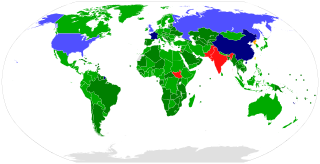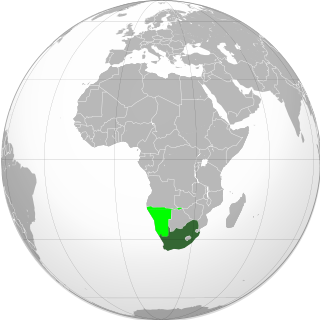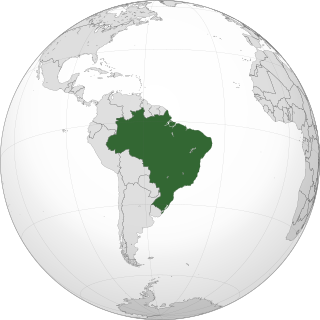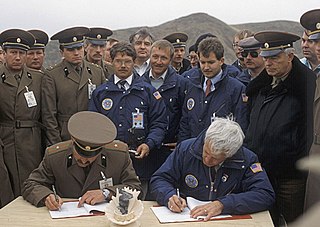
The Treaty on the Non-Proliferation of Nuclear Weapons, commonly known as the Non-Proliferation Treaty or NPT, is an international treaty whose objective is to prevent the spread of nuclear weapons and weapons technology, to promote cooperation in the peaceful uses of nuclear energy, and to further the goal of achieving nuclear disarmament and general and complete disarmament. Between 1965 and 1968, the treaty was negotiated by the Eighteen Nation Committee on Disarmament, a United Nations-sponsored organization based in Geneva, Switzerland.

Nuclear proliferation is the spread of nuclear weapons, fissionable material, and weapons-applicable nuclear technology and information to nations not recognized as "Nuclear Weapon States" by the Treaty on the Non-Proliferation of Nuclear Weapons, commonly known as the Non-Proliferation Treaty or NPT. Proliferation has been opposed by many nations with and without nuclear weapons, as governments fear that more countries with nuclear weapons will increase the possibility of nuclear warfare, de-stabilize international or regional relations, or infringe upon the national sovereignty of nation states.
Enriched uranium is a type of uranium in which the percent composition of uranium-235 has been increased through the process of isotope separation. Naturally occurring uranium is composed of three major isotopes: uranium-238, uranium-235, and uranium-234. 235U is the only nuclide existing in nature that is fissile with thermal neutrons.
Iran has several research sites, two uranium mines, a research reactor, and uranium processing facilities that include three known uranium enrichment plants.

From the 1960s to the 1990s, South Africa pursued research into weapons of mass destruction, including nuclear, biological, and chemical weapons under the apartheid government. South Africa’s nuclear weapons doctrine was designed for political leverage rather than actual battlefield use, specifically to induce the United States of America to intervene in any regional conflicts between South Africa and the Soviet Union or its proxies. To achieve a minimum credible deterrence, a total of six nuclear weapons were covertly assembled by the late 1980s.

In the 1970s and 1980s, during the military regime, Brazil had a secret program intended to develop nuclear weapons. The program was dismantled in 1990, five years after the military regime ended. Brazil is considered to possess no weapons of mass destruction but does have some of the key technologies needed to produce nuclear weapons.

Iran is not known to currently possess weapons of mass destruction (WMD) and has signed treaties repudiating the possession of WMD including the Biological Weapons Convention, the Chemical Weapons Convention, and the Non-Proliferation Treaty (NPT). Iran has first-hand knowledge of WMD effects—over 100,000 Iranian troops and civilians were victims of chemical weapons during the 1980s Iran–Iraq War.

The US–UK Mutual Defense Agreement, or the 1958 UK–US Mutual Defence Agreement, is a bilateral treaty between the United States and the United Kingdom on nuclear weapons co-operation. The treaty's full name is Agreement between the Government of the United States of America and the Government of the United Kingdom of Great Britain and Northern Ireland for Cooperation on the uses of Atomic Energy for Mutual Defense Purposes. It allows the US and the UK to exchange nuclear materials, technology and information. The US has nuclear co-operation agreements with other countries, including France and other NATO countries, but this agreement is by far the most comprehensive. Because of the agreement's strategic value to Britain, Harold Macmillan called it "the Great Prize".

Research reactors are nuclear fission-based nuclear reactors that serve primarily as a neutron source. They are also called non-power reactors, in contrast to power reactors that are used for electricity production, heat generation, or maritime propulsion.
A nuclear fuel bank is reserve of low enriched uranium (LEU) for countries that need a backup source of LEU to fuel their nuclear reactors. Countries that do have enrichment technology would donate enriched fuel to a "bank", from which countries not possessing enrichment technology would obtain fuel for their power reactors.

The South African Nuclear Energy Corporation (Necsa) was established as a public company by the Republic of South Africa Nuclear Energy Act in 1999 and is wholly owned by the State.
This is the timeline of the nuclear program of Iran.

Bulgaria has developed weapons of mass destruction, most notably chemical weapons. Chemical weapons production was concentrated in Smyadovo. As of 2016, Bulgaria does not possess any weapons of mass destruction.
President Adly Mansour announced on 7 November 2013 that Egypt was restarting its nuclear power program in El Dabaa; a deal was reached with the residents in which it was agreed that a residential area will also be built. The Egyptian minister of electricity, Ahmed Emam, has called the project "necessary" because of a small amount of renewable energy sources and not enough fuel.

The nuclear energy programs of Venezuela started during the 1950s but currently there are no active nuclear power facilities. Most of Venezuela's nuclear science activities are carried out at Venezuelan Institute for Scientific Research (IVIC).
Nuclear energy accounts for about 3% of Brazil's electricity. It is produced by two pressurized water reactors at Angra, which is the country's sole nuclear power plant. Construction of a third reactor begun on 1 June 2010, but it is currently stalled. The sole Brazilian company in charge of nuclear energy production is Eletronuclear.

Nuclear Non-Proliferation Act of 1978, 22 U.S.C. § 3201, is a United States federal law declaring that nuclear explosive devices pose a perilous threat to the security interests of the United States. The law restricts U.S. export of civil nuclear programs to other nations.
ETRR-2 or ET-RR-2, or is the second nuclear reactor in Egypt supplied by the Argentine company Investigacion Aplicada (INVAP) in 1992. The reactor is owned and operated by Egyptian Atomic Energy Authority (EAEA) at the Nuclear Research Center in Inshas, 60 kilometres (37 mi) northeast of Cairo.

The Republic of Kazakhstan, once a republic of the Soviet Union, was a primary venue for Soviet nuclear weapon testing from 1949 until 1989. Following the collapse of the Union of Soviet Socialist Republics (USSR) in 1991, Kazakhstan became the fourth-largest nuclear power in the world and hosted a considerably large weapon support infrastructure due to its reliance on the Soviet nuclear program as a means to develop its own local economy. Besides the nuclear program, Kazakhstan was also a prominent site of Soviet programs of biological and chemical weapons.
The Es-Salamresearch reactor, also known as the Aïn Oussara nuclear reactor is a nuclear research reactor in Algeria. The reactor can produce 15 megawatts-thermal and its primary uses are radiopharmaceutical production, neutron activation analysis, neutron radiography, and training. The reactor was supplied by China and built in the region of Aïn Oussera, nearly due south of the capital city of Algiers. It reached criticality in February 1992 and began operation in late 1993.











